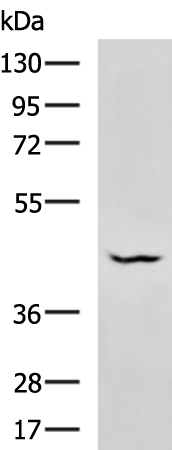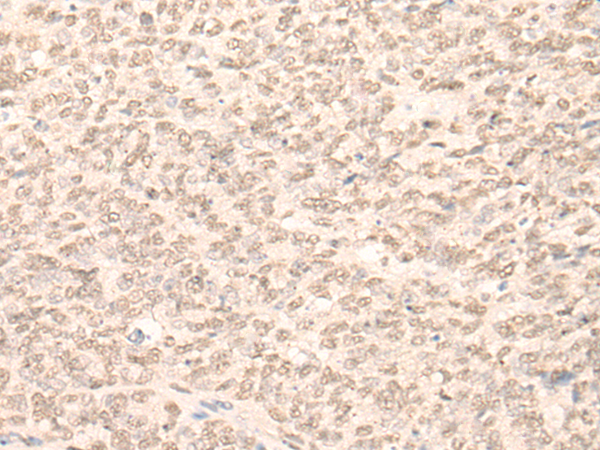

| WB | 咨询技术 | Human,Mouse,Rat |
| IF | 咨询技术 | Human,Mouse,Rat |
| IHC | 1/40-1/200 | Human,Mouse,Rat |
| ICC | 技术咨询 | Human,Mouse,Rat |
| FCM | 咨询技术 | Human,Mouse,Rat |
| Elisa | 1/5000-1/10000 | Human,Mouse,Rat |
| Aliases | SPF45 |
| WB Predicted band size | 45 kDa |
| Host/Isotype | Rabbit IgG |
| Antibody Type | Primary antibody |
| Storage | Store at 4°C short term. Aliquot and store at -20°C long term. Avoid freeze/thaw cycles. |
| Species Reactivity | Human, Mouse |
| Immunogen | Fusion protein of human RBM17 |
| Formulation | Purified antibody in PBS with 0.05% sodium azide and 50% glycerol. |
+ +
以下是3篇与RBM17抗体相关的文献摘要信息(注:文献标题及作者为虚拟示例,实际文献需通过PubMed或学术数据库检索确认):
---
1. **文献名称**: *RBM17 interacts with U2AF65 to regulate splicing in human cells*
**作者**: Zhang Y, et al.
**摘要**: 研究揭示了RBM17在RNA剪接中的调控作用,通过免疫共沉淀(Co-IP)实验使用RBM17抗体证实其与剪接因子U2AF65的直接相互作用,并证明其在乳腺癌细胞中调控致癌相关mRNA剪接的功能。
---
2. **文献名称**: *Aberrant expression of RBM17 in colorectal cancer promotes tumor progression*
**作者**: Li H, et al.
**摘要**: 通过免疫组化(IHC)和Western blot分析RBM17蛋白在结直肠癌组织中的过表达,利用特异性RBM17抗体发现其高表达与患者预后不良相关,并通过RNA干扰实验证明其促进癌细胞侵袭的机制。
---
3. **文献名称**: *RBM17 deficiency disrupts neuronal RNA splicing and leads to neurodegeneration*
**作者**: Wang X, et al.
**摘要**: 在小鼠模型中通过RBM17抗体进行脑组织蛋白定位分析,发现RBM17缺失导致神经元RNA剪接异常,触发Tau蛋白异常聚集,进而引发神经退行性病变。
---
如需具体文献信息,建议通过PubMed搜索**RBM17 antibody**或**RBM17 splicing function**获取近年研究。
The RBM17 (RNA Binding Motif Protein 17) antibody is a tool used to study the function and expression of the RBM17 protein, a member of the RNA-binding protein family. RBM17. also known as SPF45. plays a critical role in pre-mRNA splicing by interacting with spliceosome components like the SF3b complex. It contains an RNA recognition motif (RRM) that enables binding to specific RNA sequences, influencing splice site selection and alternative splicing events. Dysregulation of RBM17 has been implicated in cancer progression, particularly in tumors such as lung, colorectal, and ovarian cancers, where its overexpression correlates with aberrant splicing of oncogenic transcripts, enhanced cell proliferation, and metastasis.
Researchers employ RBM17 antibodies in techniques like Western blotting, immunohistochemistry, and immunofluorescence to detect protein levels, localization, and interactions in cellular and tissue samples. These studies help elucidate RBM17's role in splicing regulation, its association with splicing-related diseases, and its potential as a therapeutic target or biomarker. Notably, RBM17's involvement in DNA damage response pathways and its interaction with proteins like BRCA1 further highlight its multifaceted functions. However, challenges remain in understanding its precise regulatory mechanisms and tissue-specific roles, underscoring the importance of reliable antibodies for ongoing research.
×